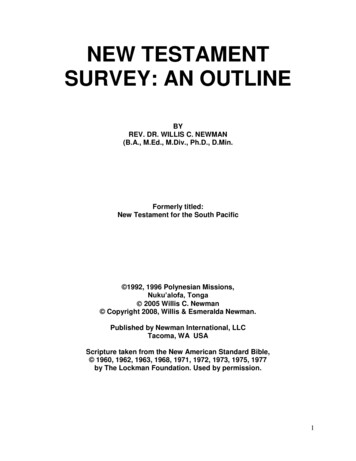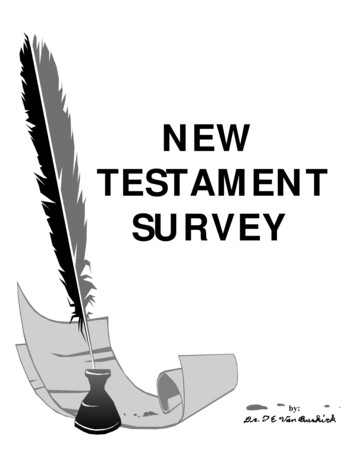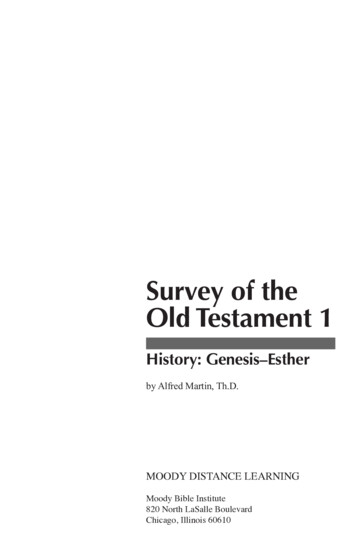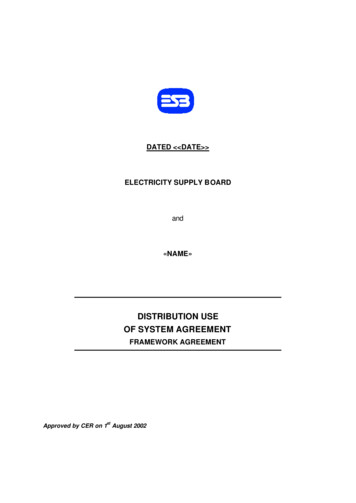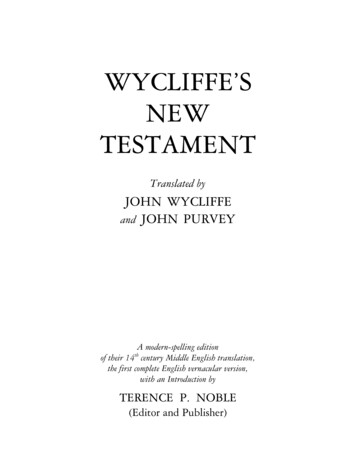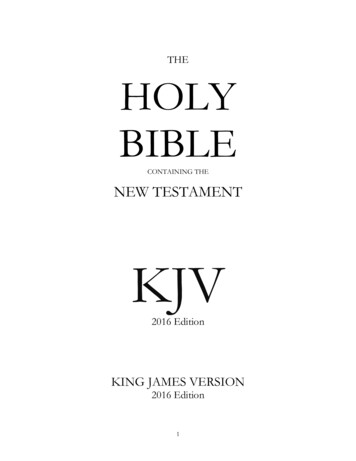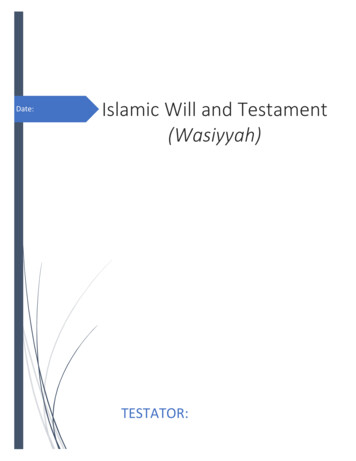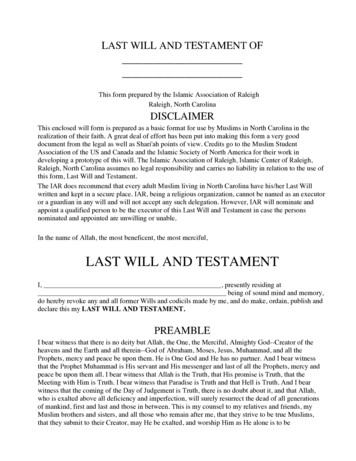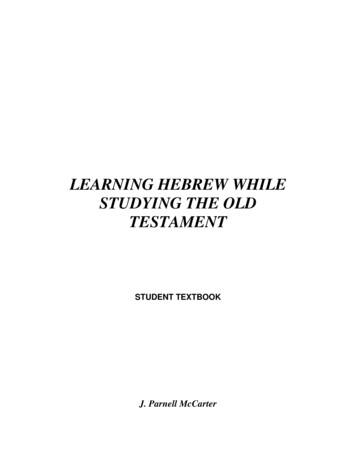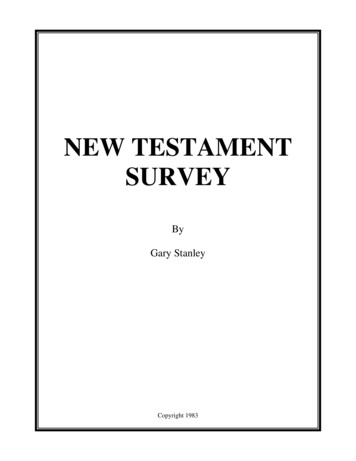
Transcription
NEW TESTAMENTSURVEYByGary StanleyCopyright 1983
Dear New Staff,As Howard Hendricks notes in Living by the Book, “The Study of the Bible is .More than a duty, it provides protection for the daily battle, comfort for the dashed hopes,and continuing education for a life that is worth living.”It is with those thoughts in mind that you hold in your hands another tool, onemore block for the foundation of you ministry for a lifetime. As we have had anopportunity to preview several New Testament Survey courses, we have not found thatone that communicates a passion for the Word and its application to life and ministry theway this course by Dr. Gary Stanley does.Though it has been several years since Gary recorded these lectures – his words,humor, drama, and skill are timeless. It is our desire that you be staff who are full ofcharacter, firm in conviction, innovative and effective in ministry and resourcefulthinkers. No doubt you study and knowledge of the New Testament is an essential to thatend. Please use this course and His Word as a tool to dig up the soils of your heart, lifeand ministry, as you grow in the Lord and make Him known to others.Sincerely in Christ,Marc RutterNational Director of Leadership DevelopmentKeith Johnson, Ph.D.Director of Theological EducationP.S. We pray these timeless words for you. “Open my eyes, that I may behold wonderfulthings from thy law” (Psalm 119:18)i
PrefaceJune 2007The New Testament Survey course you hold in your hands began in 1979 at ArrowheadSprings. For eleven years I had the privilege of teaching this class every winter andsummer to nearly 8,000 students through the Institute of Biblical Studies.With each new class the content was revised and adapted to the needs of a very specialaudience-the New Staff of Campus Crusade for Christ. The material soon outgrew thetwenty hours of lecture and The Garimus File (1983) was published to make room forthis "work in process."In 1990 this version of the New Testament Survey was laid to rest. I did not have theheart to merely say good-bye to this "old friend" so I edited the taped lectures from yearsgone by, and filed them along with the class notes in the International School ofTheology library.I hadn't given much thought to the possibility of this class becoming a correspondencecourse, but I'm very grateful someone else did. My only regret is that I won't be there inperson to introduce you to the old friends and eternal truths that live within the pages ofthe New Testament. However, I've asked the Real Teacher of this course to do just that.Enjoy,Gary StanleyP.S. I am now the Academic Dean of Rivendell College in Boulder, Colorado(rivendellcollege.org). These days I’m more likely to teach something in spiritualformation, but I occasionally find myself drawn back to New Testament Survey—nowdays with PowerPoint, movie clips and new monologues from the characters thatpopulate this most amazing book. It is a high honor to walk this road with you.P.S.S. Feel free to drop me a note and tell me how goes the class gary@garimus.comii
New Testament SurveyInstructor: Gary StanleyClass SyllabusI. Class ObjectivesAs a result of this class you should be able to:1. Outline and discuss the general background history of the Inter-testamentalperiod including its institutions and literature.2. Define and address the general questions faced in the discipline know as NewTestament Criticism.3. Outline the major events that shaped the character of the Apostle Paul.4. Give the general background and content of each New Testament book.5. Demonstrate an “ear” for the distinctives of each New Testament book basedon the approach of this class.6. Trace the movements of Paul in the New Testament world.7. See an increased appreciation for the New Testament in your personaldevotions and witness.II. TextbooksAn Outline of New Testament Survey by Walter Dunnett (Chicago: Moody,1960) [see course packet]The Garimus File by Gary Stanley (San Bernardino: Here’s Life, 1983) [seecourse packet]The New Testament Manual by Gary Stanley (Ft. Collins: IBS 1983 &1995) [thisfollows this syllabus]Note: New Testament Survey by Merrill Tenney (Grand Rapids,Eerdmans, 1985) is frequently referred to in the manual by the authorsname alone.iii
III. Class OutlineNOTE: The lectures are available on-line: http://virtualibs.ccci.org/course/view.php?id 7SESSIONLECTUREREADINGASSIGNMENTS1“What’s It All AboutAlphesus?”Introduction2“Silence is Golden”3“You Take the High Roadand I’ll take the Low Road”(New Testament Critcism)Dunnett 14 – 214“Royal Ledgers andDelinquent Accounts”Dunnett 22 – 35;any 5 chapters of Matthewand 3 chapters of Mark5“A Case of Corpus Delicti”Dunnett 46 – 53; andAny 7 chapters of John6“A Diagnosis of Theophilus”[Note: Reading Assignments are due [Note: Assignments and quizzesat the beginning of the session forare before the session whichwhich they are assigned.]they are assigned.]Dunnett 7 – 13Quiz #1SpecialAssignment # 1Dunnett 36 – 45;all of LukeQuiz # 2SpecialAssignment # 27“Breaking Away”Dunnett 54 – 68;Garimus 18 – 25;all of Acts8“The Apprenticeship of aTentmaker”Dunnett 69 – 73;Garimus 8 – 169“Uptight and Out of Sight”Dunnett 73 – 80,93 – 98;Garimus 26 – 42;Galatians, I & II Thess.10“A Product of Environment”Dunnett 81 – 92;I & II CorinthiansivQuiz # 3
11“The Road Not Taken”Dunnett 98 – 103; Romans12“Cutting Apron Strings”Dunnett 104 – 115;Garimus 44 – 51;Ephesians & Colossians13“Under the Circumstances”Dunnett 115 – 121;Garimus 52 – 70;Philippians & Philemon14“Last Wills and Testaments”Dunnett 122 – 133;Garimus 72 – 87;I & II Tim. and TitusSpecialAssignment # 315“The One That Didn’t GetAway”Dunnett 147 – 153;Garimus 88 – 101;I & II PeterQuiz # 516“Don’t Stand on Ceremony”Dunnett 134 – 141;HebrewsQuiz # 617“Advice from Two LittleBrothers”Dunnett 141 – 146, 159 – 162;Garimus 1 – 7;James, JudeSpecialAssignment # 418“Endangered Species”Dunnett 153 – 159;Garimus 102 – 111;I, II, & III John19“From Here to Eternity”Dunnett 163 – 172;RevelationQuiz # 720“And Back Again”Garimus 112 – 113SpecialAssignment # 521Quiz # 4Study for final: StudyGuide can be found at theend of the SyllabusFinal Examv
Sample ScheduleThis schedule shows a sample timeline of how you might complete the course. Begin by filling in thestarting date and completion date (see below). You may find it helpful to fill in dates for each of theweeks. Here are the deadlines: January training: deadline June 1 (same year)May Mid-Career training: deadline December 1 (same year)Summer training: deadline December 1 (same year)September training (Stint to staff) January 1 (following year)September training (Mid-Career) March 1 (following year)DateAssignments to be CompletedWrite your starting date here:Week 1Session 1Session 2Week 2Session 3Session 4Week 3Session 5Session 6Week 4Session 7Session 8Week 5Session 9Session 10Week 6Session 11Session 12Week 7Session 13Session 14Week 8Session 15Session 16Week 9Session 17Session 18Week 10Session 19Session 20Week 11Study and take FinalWrite your projected completion date here:Email Grade Sheet postmarked by this date.vi
IV. Written AssignmentsA. Weekly Journal and Bible ReadingsThe Scriptural readings are meant to be interactive – i.e. ponder, listen, and replayas you read. The journal is to help you integrate the readings with your life while takingthis course.Journaling is one of the best ways to commune with God. Putting your thoughts andinsights on paper does several things: it focuses your thoughts and slows your mind downto a navigable speed; it preserves some of the heart lessons God teaches those who spendtime in His Word, and serves as a reminder of His activity in your life.Instructions: This is to be a weekly journal, not an “all-nighter” journal done at theend of the course. Write in your journal every week (obviously, a “daily” journal wouldbe even better). Do your journal in some kind of notebook, i.e. no loose or stapled pages(or on the computer if that’s easier for you).Follow the format given below:1. Read the assigned Scriptural text during the week.2. Select a verse(s), or phrase, or from your readings; write it out alongwith the reference.3. Write out your thoughts, feelings, and insights on your selected passage(be sure to think about how your verse relates to the broader context). Youmay find it helpful to address those thoughts to your heavenly father).4. In light of your reading and reflection, consider how God is leading you torespond to Him. You might consider whether there are any recurring themes inyour journaling. The following questions may also be helpful: How does thispassage challenge you to think differently about God? What false beliefs does itexpose? What aspects of God’s character does it invite you to embrace? Howdoes it lead you to worship Christ? How does it challenge you to think differentlyabout yourself? Is there some specific action you believe God is asking you take?Note: You may find that the Garimus File gives you some direction or topics for yourjournaling. No one will read your journal. The journaling begins with session #4 andends with session #19. You are to do one journal entry per week (not per book). Youwill have 16 entries in all (if you listen to one tape each week).Grading: The journal and Biblical readings are worth 75 points and will be gradedby each student using the following criteria:- 50 Points for reading 100% on the Scriptural readings- 25 points for doing the journal every weekEach student will estimate the percentage of each criterion s/he has accomplished andsubmit that grade.See the example on the following page.vii
Example of the journal format:3. I will write a letter home expressing my commitment to my parentsand God’s calling. *Note: This journal entry was written by Rory Jordan two days before his death.* (My addition to show the assignment’s format)viii
B. Getting the Lay of the LandOne of the most rewarding (and most neglected) tools in the study of the NewTestament is understanding the “lay of the land.” As you read Acts, follow Paul’smovements on the map in the back of your bible and trace them on the mapsupplied in the manual.Note: If you go through the trouble of including at least 50 locations (cities,regions, countries, bodies of water, etc.), you will receive full credit. However, thegoal of this exercise is to begin the process of moving the maps in the back of yourBible into your understanding of the New Testament.Grading: 25 points possible determined by identifying 50 locations.C. Special AssignmentsAt the end of some sessions you will find a “special assignment.” These assignmentswill be enjoyable and encouraging. They will help integrate what you are learning fromthe New Testament with your time in ministry. The assignments are listed here but aredetailed throughout your manual.The Assignments are:1. Chose three people that you would like to encourage and write them postcards.You might share something God is teaching you.2. Lessons on Spiritual Leadership: an Interview with a Pastor. Note that thisassignment may take some forethought and planning. Make sure you plan thisassignment into your MPD schedule at time that you are in the town where youwould feel comfortable meeting with a pastor. You can do this assignment beforeyou reach this place in your class if you need to, just flip to the page and get allthe details for the assignment.3. Portraits of Prayer: Call or write your ministry director and ask for specificinformation so that you can pray for the ministry.4. Reflections on Faith and the master.5. What you read is not what you hear. Listen to one of the listed books of the bibleon audio or watch one of the listed movies about the Bible.Grading: Each Special Assignment is worth 20 points. Total points 100.ix
D. Quizzes on Readings from DunnettThere are quizzes taken from the assigned readings from Dunnett inserted at thebeginning of several sessions. Take the quiz before listening to that session’slecture and grade yourself using the answer key found in the back of the manual.Grading: The quizzes are worth a total of 50 points.E. FinalThe final exam covers only the manual and the class lectures (Dunnett is coveredby the quizzes). The final is made up of 131 questions consisting of matching,true/false, and multiple guess. The questions draw equally from all sessions.Note: This final is for real. It is designed to evaluate you as a New Testamentstudent – it rewards those who study.V. Grading ProceduresAssignmentPoints PossibleWeekly Journal and Bible Readings75Lay of the Land25Special Assignments100Quizzes from Dunnett50Final Exam131Total Points:381VI. Recommended Readings An Introduction to the New Testament by D.A. Carson, Douglass J. Moo, and LeonMorris, Zondervan. New Testament Introduction by Donald Guthrie, Inter-Varsity Press. Introduction to the New Testament by Everett Harrison, Eerdmans. An Introduction to the Pauline Epistles by D. Edmond Hiebert, Moody Press. A Self-Study Guide by Irving Jensen, Moody Press. Letters to Street Christians by Two Brothers from Berkeley, Zondervan. The Origin and Transmission of the New Testament by L.D. Twilley, Eerdmans. The Christ Commission by Og Mandino Talk Thru the New Testament by Bruce Wilkinson and Kenneth Boa (Nashville:Thomas Nelson Pub., 1983)x
Final Exam Study GuideNote: This study guide is not meant to be exhaustive and there may be questions on thefinal exam that are not addressed in this study guide. It is meant to be a guide to help youknow how much detail you need to know on some topics.Review for Final Canonicity, general timeline, principlesgoverningIntertestamental periods (and theirmeanings)Intertestamental literatureThe “Q” sourceAncient manuscriptsTextual criticismForm criticismRedaction criticismHigher and Lower criticismFor each book know:o characteristicso outlineo major themeso author(s)o where they were written fromo time frame when writteno purposeo audience Timeline of Paul’s lifeevents God used to shape Paulorder books were writtenNames of Jesus’ disciplesSeptuagintWho founded the church at RomeInterpretations Hebrews 6GnosticismEschatologyschools of interpretationviews on millenniumDifficulties commonly encountered inunderstanding the epistlesNew Testament writers and theircharacteristicsInstructions for Taking the Final1. Take the final exam online (http://virtualibs.ccci.org/course/view.php?id 7).2. Complete the grade sheet (available for download at same link above).3. Email your grade sheet to ibs.info@uscm.org.xi
AcknowledgementsJ. Sidlow Baxter once observed of his own scholarship, “Idraw my milk from many cows but the cheese is mine.”Most (if not all) of what you have before you is anextension of someone else’s labor. I’ve noted most of thesources for this manual but there is little doubt that a poormemory (and an equally poor filing system) has leftunsung some author who has left his fingerprints on thiswork. Please accept my apologies.
The New Testament Survey course you hold in your hands began in 1979 at Arrowhead Springs. For eleven years I had the privilege of teaching this class every winter and summer to nearly
